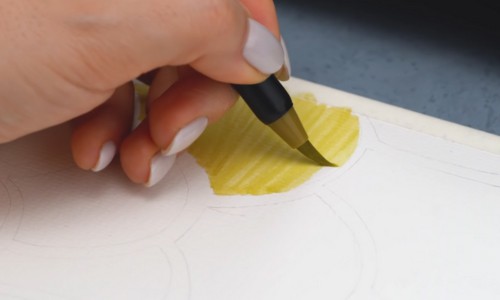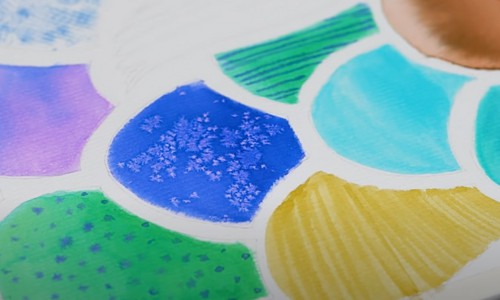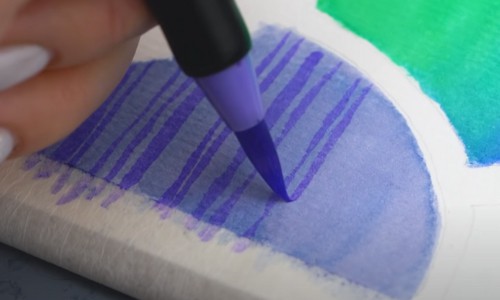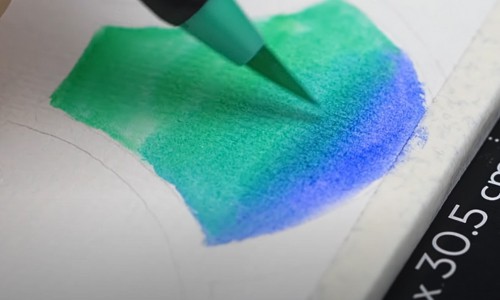Arteza real brush pens are perfect for many people, as they offer a wide range of colors and can produce stunning effects. However, they can also be challenging to master, especially for beginners who may struggle with mixing colors, controlling water, and creating gradients.
How to use Arteza Real brush pens? You can use Arteza watercolor pens with or without water to achieve different effects, and even combine contrasting colors for a unique touch.
This article will delve into each technique, providing a detailed guide to elevate your artwork. They are all easy things, so let’s keep reading!
Table of Contents
Ways To Use Arteza Real Brush Pens
1. With Water
Before delving into all the exciting techniques for using Arteza watercolor brush pens with water, let’s take a moment to understand some important dos and don’ts.
Do
When it comes to drawing with a brush pen, dip the brush tip lightly into the water if you want deeper hues. Extend the immersion time to more than one second for lighter color payoffs.
To create smooth transitions and gradients, apply one color, then quickly touch the tip of a second color to the wet area. The shades will blend seamlessly.
Don’t
Wet the brush so much that all pigments transfer to your dipping water.
Avoid pressing too hard on the brush pen tip, as this can damage it. A light touch is often all that’s needed to release the desired amount of color.
Technique 1: Wet pen on dry paper
- Step 1: Choose the Arteza watercolor pens with the colors you want to use for your gradient. Draw on paper with them to create a strong, vibrant shape or streak of color.
- Step 3: Next, gently dip the tip of your Real Brush Pen into a cup of clean water. Be cautious not to soak it; a light dip will suffice.
- Step 4: Start applying the wet brush directly onto dry paper. As you do so, you’ll notice that the color begins to change tone, transitioning from a more saturated hue to a lighter shade.
Technique 2: Dry pen on wet paper
- Step 1: Select a Real Brush Pen color.
- Step 2: Pre-wet the background of your paper. Apply a light layer of water where you intend to create the background.
- Step 3: Fill the detailed areas of your drawing with the selected color using the dry Real Brush Pen. The wet paper will make the colors blend and flow beautifully.
After applying one color, feel free to add other shades as needed, just like you would with a traditional watercolor painting.
Technique 3: Creating water stains
- Step 1: Select a dark and vibrant color from your Arteza Real Brush Pen set. Dark colors such as deep blue or rich purple tend to make the effects more noticeable and striking.
- Step 2: Prewet the area, but do not make it overly wet!
- Step 3: Take your chosen dark color Real Brush Pen and paint over the damp area on the paper. The ink will start to spread and blend with the water, creating a soft, colored background.
- Step 4: Wait for a short period to let the moisture ‘evaporate’ slightly.
- Step 5: Drip small amounts of water onto the painted area. The water will interact with the ink and start to flow, forming captivating patterns and textures. You can also tilt the paper to quicken the process.
Technique 4: Using salt for crystalline patterns
- Step 1: Prewet the paper.
- Step 2: You should take the dark-colored Real Brush Pen and paint over the wet area. The ink will start to blend with the water, creating a soft, colored background.
- Step 3: While the painted area is still wet, carefully sprinkle a small amount of table salt onto the paper. Be cautious not to pour too much, as a light sprinkling will yield the best results.
- Step 4: As the salt settles onto the wet ink, it will begin to interact with the pigment. After a couple of minutes, you’ll notice that the salt has started to form a crystalline pattern.
- Step 5: Once your artwork is fully dry, gently brush off any excess salt with a clean, dry brush or a soft cloth.
2. Without Water
Before trying the Arteza Real brush pen techniques below, note that you can adjust the application pressure to create bolder or finer lines.
Technique 1. Dry pen on dry paper
- Step 1: Choose your favorite color and draw it right on dry paper. You should hold and use brush tip markers as you would a regular pen or brush. This initial step is crucial for getting comfortable with the pen’s feel and control.
- Step 2: Then, you can create basic shapes and lines on your work. Wait for one layer to dry before drawing another to create a deeper layer or depth.
You also can mix and match colors to create vibrant and dynamic illustrations. Combining complementary or contrasting colors can yield striking effects.
Technique 2. Creating textures
- Step 1: Select the Real Brush Pen colors you want to use for your artwork. Keep in mind that lighter or earthy tones can work particularly well to enhance the rough texture effect.
- Step 2: Hold your Real Brush Pen and apply light pressure to the bristles by gently pressing them down or flattening them slightly.
- Step 3: Start painting on your paper while maintaining the light pressure on the brush pen. As you move the tip around, the flattened bristles will interact with the paper’s texture, creating the shapes and outlines you want.
- Step 4: Vary your strokes and direction to emphasize the roughness or texture of the drawing even more.
3. Gradient Color Mixing
- Step 1: Select two Arteza Real Brush Pens in different colors that you’d like to blend. For this example, let’s use a green and a blue pen.
- Step 2: Add one color to your paper. Then, add the second color on the opposite side of the first one. Overlap the two shades in the middle, blending them smoothly with each other. This technique creates a natural transition between the two hues.
- Step 3: To achieve a smoother gradient effect, gently go over the intersection of the two colors with a water brush pen.
Conclusion
This is the end of the Arteza Real watercolor pens tutorial. Mastering how to use Arteza Real Brush Pens offers artists a world of creative possibilities. These versatile tools can be applied in various ways, with or without water to achieve stunning effects in your artwork.
Whether you’re experimenting with contrasting colors to create seamless gradients or blending edges to craft unique shades, these pens empower artists to bring their visions to life.

Art has always been a part of my life; it influences my upbringing and later my career choice. For me, it is always a part of my parenting technique. So for whichever purpose that you come to art, you can start here with us.







